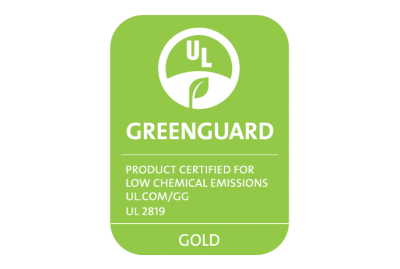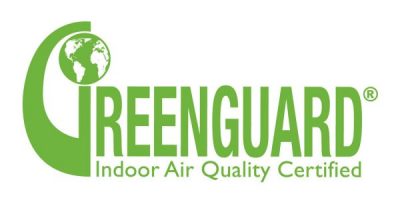Earth Day is a global event celebrated around the world it’s 48th year and making it a priority to help save our valuable planet. A lot of our office furniture manufacturers have put a lot of emphasis on creating lines that are earth friendly and make a less of an impact on our environment.
Many of our lines we offer such as Cherryman, Office Source, JSI, 9 to 5 Seating, Artopex, Friant, Office Masters, Lesro, Candex and many more.
Look for green guard certification and below is this symbol.
“GREENGUARD Certification is part of UL Environment, a business unit of UL (Underwriters Laboratories). GREENGUARD Certification helps manufacturers create–and helps buyers identify–interior products and materials that have low chemical emissions, improving the quality of the air in which the products are used. All GREENGUARD Certified products are listed in the UL SPOT Sustainable Product Database.“


Here are a few more tips to help make your office more green.
1. Determine Your Energy Consumption
Many companies put the cart before the horse by launching green initiatives without first benchmarking their current energy and raw-material consumption. But before you begin being green, you have to know how ungreen you really are. The EPA’s Energy Star program offers a set of tools called Portfolio Manager to help you gauge your energy and water use. The agency has also developed spreadsheets (“energy performance indicators”) that allow manufacturers in certain industries to judge their own consumption.
2. Use Less Paper
It’s easy to print out your e-mails or copy a pdf presentation for 30 people without ever considering the trees and the energy it takes to create those crisp, white sheets. U.S. businesses still use about 21 million tons of paper each year. It doesn’t have to be this way. Paperless contracts are real, and their popularity is growing more everyday. Thanks to a law passed by Congress in 2000, any signature made electronically—whether it’s typing your name at the bottom of an e-mail, pushing an “Accept” button, or using an electronic pen and pad—is just as binding as an old-fashioned pen-and-paper John Hancock.
3. Take a Look at Your Windows
In 2007, Anthony Malkin, whose family owns the Empire State Building and whose real-estate investment firm manages it, announced a plan to reduce the skyscraper’s energy use 38 percent by 2013, saving $4.4 million in the process. Surprisingly, changing the windows will play a big part in the money savings. Malkin contracted Serious Materials, a manufacturer of sustainable windows and drywall based in Silicon Valley, to make energy-efficient all 6,514 windows—roughly 26,000 panes of glass in the historic building. But Malkin, who had had new, dual-pane windows installed as recently as the 1990s, hated the idea of simply throwing all that glass away. Serious Materials has a process that transforms the old glass into super-insulating glass four times more efficient than most energy-efficient windows.
4. Turn Out the Lights
Overhead lighting is the biggest electricity hog in the typical commercial building, and the traditional T12 (1.5-inch) fluorescent tube dates from the 1930s. Moreover, the heat generated by such bulbs taxes the building’s cooling system. Replace the lamps with newer high-performance T8 (1-inch) tubes and the fixture’s magnetic ballasts (which regulate current to the bulb) with electronic ones, and you will reduce the electric load 42 percent, according to the energy analysts at E Source. New lenses and reflectors on the fixtures will reduce energy consumption 71 percent. Daylight dimming controls and occupancy sensors reduce the load 83 percent and have a payback of just 3.3 years. Another tip: consider installing light sensors overhead that will automatically turn the lights on and off based on the amount of sunlight streaming in from windows or the amount of movement in a particular area.
5. Plant a Green Roof
Covering a building’s roof with plants can reduce stormwater runoff and keep a building cooler. But green roofs are difficult to install, especially on existing buildings that weren’t designed to support the extra weight of watered plants. So do your homework before painting your thumb green.
Companies such as the Barthelmes Manufacturing Company based in Rochester, New York, installs edible walls — metal panels filled with soil and seeds and hung vertically. This trend in green roof technology adds an edible wall of thick vegetation on the outside of buildings to provide insulation and reduce heating and electricity costs. They have the added benefit of producing fruit, vegetables and herbs, in comparison to green roofs.
6. Use Organic Paint and Other Green Design Materials
When decorating your offices, consider using recycled materials in places you may not have thought it was possible. Chuck Richards of the Sunset Athletic Club in Portland, Oregon, painted his walls with a product from MetroPaint, a regional government program in Oregon that recycles leftover latex paint. Organic paint is another good option. Companies such as AFM, BioShield, and Dunn-Edwards create products that is slightly more expensive than conventional latex-based paint, and it is biodegradable and emits fewer noxious fumes.
You can also look into green floors. Carpet tiles from companies such as Interface and Avalon are made from recycled materials and they are modular, so when one square area becomes worn, you can replace it without tearing up the entire carpet. Bamboo mats and formaldehyde-free wool carpets are also available at reasonable prices.
Lastly, consider purchasing green office furniture. Companies such as Herman Miller, Baltix, and Formway offer durable products made from recycled or recyclable materials. Baltix’s Ecobuzz workstations, for example, are nontoxic and made from sunflower hulls, soybeans, and wheat straw.
7. Purchase Energy Efficient Equipment
Office equipment has been for years a source of pollution and waste, producing tons of non-recyclable plastics, dangerous chemicals, and massive amounts of non-biodegradable components. In addition, inefficient office equipment does not just suck more electricity; like lighting, it also warms the interior space. Luckily, there’s an abundance of ways to green your office equipment.
8. Encourage Carpooling or Alternatives to Driving
Offer transit passes to employees who take the bus or subway and bike racks for cyclists. Let workers telecommute when it’s not essential that they be in the office. Clif Bar founder Gary Erickson launched a Cool Commute program at his company, which awards $5,000 to employees who buy biodiesel or hybrid vehicles. The program also awards points–redeemable for transit vouchers or gift cards–to Clif Bar employees who carpool, walk, bike, or take public transportation to
9. Allow Employees to Telecommute
Telecommuting is spreading like wildfire through small businesses around the country. A study conducted last year by Fort Lauderdale-based Citrix found nearly a fourth of American workers and 41 percent of small-business owners regularly work remotely. In the same survey, business owners considered telecommuting a more significant employee perk than stock options or workplace childcare. When David Nilssen went searching for ways to cut down on office space at his Bellevue, Washington, financial services company, Guidant Financial Group, he decided to send some of his 110 employees home. The company’s 15-person Web publishing team works remotely, bringing the total number of telecommuters at the company to 20. Nilssen will supply these employees with laptops and Internet connections — costs he would incur even if they worked in the office. Guidant has also begun testing out four-day, 40-hour weeks for some administrative employees. The workers will have rotating schedules and share desks to cut back on the need for space.
10. Cash in on Government Incentives
In the spirit of saving the best for last, it doesn’t hurt to make a little money on your path to sustainability. Recent stimulus bills created and extended tax incentives for green initiatives. But the Feds aren’t alone in attempting to green the economy. In some states, the combined incentives can defray 80 percent of the initial cost of installing rooftop solar panels.
Article Credit:
